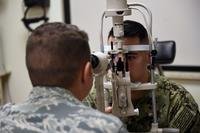By Tom Philpott
The Senate has voted to end a special food allowance stateside that was conceived 14 years ago primarily to avoid more news reports of military families using food stamps. On that original goal it failed miserably.
The idea behind the Family Subsistence Supplemental Allowance (FSSA) was to offer junior enlisted with large families an alternative to food stamps, in fact to make them financially ineligible for such assistance.
In doing so Congress affirmed that American society, and particularly its politicians, associate food stamps with poverty and, in the most negative sense, with government handouts.
Indeed seven years after enacting FSSA to try to separate military families from the food stamp program, Congress tried to reduce the stigma of food stamps by rebranding it as the Supplemental Nutrition Assistance Program or SNAP.
For financially distressed military families, however, food stamps or SNAP is much preferred over the FSSA, as the Military Compensation and Retirement Modernization Commission explained in its final report. The Senate now has embraced report recommendations to accept a more realistic approach to military food assistance, and to make a first-ever commitment to track the true number of military households using food stamps.
The Senate-passed 2016 defense authorization bill calls for an end to FSSA inside the United States. FSSA would continue overseas where SNAP isn’t available. The bill also would encourage the Department of Defense to press the Department of Agriculture, which administers SNAP, to track for the first time the number of active duty members receiving benefits.
The House so far has declined to support ending FSSA stateside, arguing some families still might need it. Instead the House proposes that the U.S. Comptroller General review military participation in nutrition assistance programs.
The commission used available USDA data to estimate that between 2000 and 22,000 military households receive SNAP benefits. Though the commission conducted some of the most thorough research to date on food assistance given military families, commissioners came away frustrated that no federal department or data source could be used to calculate a reliable number on military households that receive SNAP benefits.
SNAP provides money using Electronic Benefit Transfer (EBT) cards. It’s enough that monthly household spending on food reaches a maximum allotment set by household size, and assuming 30 percent of net household income is spent on food. SNAP can only be used to buy certain nutritional foods but recipients are under no obligation to inform their service branches when using benefits, unless they also are receiving FSSA.
FSSA distributes cash without purchasing restrictions, enough to raise a member’s household income to 130 percent of the federal poverty level, the threshold of eligibility for SNAP in many states. FSSA is made part of Basic Allowance for Subsistence and cannot exceed $1100 a month.
The commission said FSSA not only is less generous than SNAP but has more stigmas attached because applications must clear commands, a process that “may impair the quality of life and careers of service members.”
Only 285 service members qualified for FSSA in 2013, about three percent of 8486 total applicants.
One fact the commission discovered about SNAP, which troubles family advocates, is that eligibility can be lost when financially strapped families more into high-cost housing areas. That’s because their Basic Allowance for Housing climbs too, often pushing total income above SNAP thresholds.
“A family of the same rank, same family size, including non-working spouse, could qualify for SNAP in Texas but not in Northern Virginia because the housing allowance there is higher,” explained Joyce Wessel Raezer with National Military Family Association. “I would argue that…even though their housing allowance got bigger, they are still in the same financial situation.”
Raezer proposes that SNAP change how military housing allowances are counted as income, perhaps by directing states to ignore housing allowances that exceed a national housing allowance average by pay grade.
Commissioner Michael R. Higgins, who served on the professional staff of the House Armed Services Committee as a personnel issues expert from 1990 through 2013, recalled in a phone interview why Congress established FSSA. It was reacting, he said, to constituent distress over news reports that some military people needed food assistance to buy enough groceries.
Lawmakers, Higgins said, weren’t satisfied with explanations that four or more dependents for very junior grades will trigger food stamp eligibility.
“Everybody wanted to do something to prevent this alarming outcome [of] service members and families [relying] on food assistance,” Higgins said. “FSSA was the culmination of an extended debate. Unfortunately, [it] suffered from the same dilemma we encounter today: Nobody really knew how many people in the military were receiving food assistance.”
Congress understood that eligibility for food stamps was largely a function of family size.
“But that explanation was not satisfying on a political level,” Higgins said. “It didn’t defuse the question of why our warriors…are eligible for a benefit associated with people of very low income.”
So is the stigma of military folks on food stamps so great that it might justify raising allowances based on family size?
“That’s a very serious question,” Higgins said, and getting to yes “would be very difficult.” One worry, he said, would be second-order effects.
If more children sparked higher allowances, he quipped, then “we would have to expand [base] hospitals for all the kids that would be born.”
Asked how commissary patrons should react to the sight of young service members using SNAP cards, Raezer advised this:
“Say good for them. They’re making use of every resource available to help themselves financially.”
But Congress should understand, she added, that every cap imposed on yearly military pay raises only leads to more members using SNAP cards.
To comment, write Military Update, P.O. Box 231111, Centreville, VA, 20120 or email milupdate@aol.com or twitter: @Military_Update



